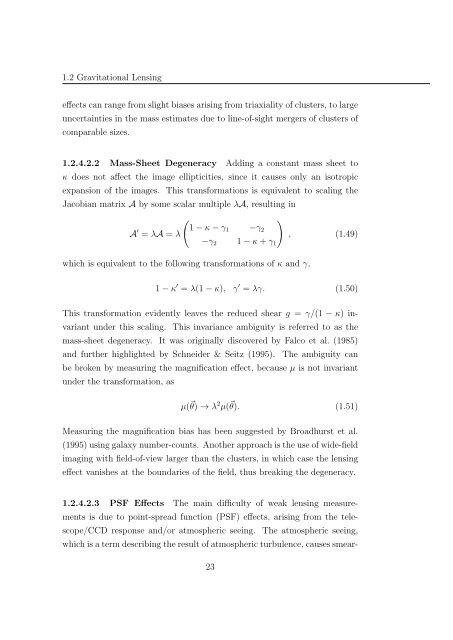Mass and Light distributions in Clusters of Galaxies - Henry A ...
Mass and Light distributions in Clusters of Galaxies - Henry A ...
Mass and Light distributions in Clusters of Galaxies - Henry A ...
You also want an ePaper? Increase the reach of your titles
YUMPU automatically turns print PDFs into web optimized ePapers that Google loves.
1.2 Gravitational Lens<strong>in</strong>g<br />
effects can range from slight biases aris<strong>in</strong>g from triaxiality <strong>of</strong> clusters, to large<br />
uncerta<strong>in</strong>ties <strong>in</strong> the mass estimates due to l<strong>in</strong>e-<strong>of</strong>-sight mergers <strong>of</strong> clusters <strong>of</strong><br />
comparable sizes.<br />
1.2.4.2.2 <strong>Mass</strong>-Sheet Degeneracy Add<strong>in</strong>g a constant mass sheet to<br />
κ does not affect the image ellipticities, s<strong>in</strong>ce it causes only an isotropic<br />
expansion <strong>of</strong> the images. This transformations is equivalent to scal<strong>in</strong>g the<br />
Jacobian matrix A by some scalar multiple λA, result<strong>in</strong>g <strong>in</strong><br />
A ′ = λA = λ<br />
(<br />
)<br />
1 − κ − γ 1 −γ 2<br />
−γ 2 1 − κ + γ 1<br />
which is equivalent to the follow<strong>in</strong>g transformations <strong>of</strong> κ <strong>and</strong> γ,<br />
, (1.49)<br />
1 − κ ′ = λ(1 − κ), γ ′ = λγ. (1.50)<br />
This transformation evidently leaves the reduced shear g = γ/(1 − κ) <strong>in</strong>variant<br />
under this scal<strong>in</strong>g. This <strong>in</strong>variance ambiguity is referred to as the<br />
mass-sheet degeneracy. It was orig<strong>in</strong>ally discovered by Falco et al. (1985)<br />
<strong>and</strong> further highlighted by Schneider & Seitz (1995). The ambiguity can<br />
be broken by measur<strong>in</strong>g the magnification effect, because µ is not <strong>in</strong>variant<br />
under the transformation, as<br />
µ( ⃗ θ) → λ 2 µ( ⃗ θ). (1.51)<br />
Measur<strong>in</strong>g the magnification bias has been suggested by Broadhurst et al.<br />
(1995) us<strong>in</strong>g galaxy number-counts. Another approach is the use <strong>of</strong> wide-field<br />
imag<strong>in</strong>g with field-<strong>of</strong>-view larger than the clusters, <strong>in</strong> which case the lens<strong>in</strong>g<br />
effect vanishes at the boundaries <strong>of</strong> the field, thus break<strong>in</strong>g the degeneracy.<br />
1.2.4.2.3 PSF Effects The ma<strong>in</strong> difficulty <strong>of</strong> weak lens<strong>in</strong>g measurements<br />
is due to po<strong>in</strong>t-spread function (PSF) effects, aris<strong>in</strong>g from the telescope/CCD<br />
response <strong>and</strong>/or atmospheric see<strong>in</strong>g. The atmospheric see<strong>in</strong>g,<br />
which is a term describ<strong>in</strong>g the result <strong>of</strong> atmospheric turbulence, causes smear-<br />
23
















